Hey, there! Ready to turbocharge your coding with Gemini 2.5 Flash, Google’s shiny new AI model, right inside Cursor and Cline? I set up Gemini 2.5 Flash on my local machine and trust me—it’s like having a coding guru whispering brilliant ideas in your ear. In this beginner’s guide, I’ll guide you through installing and using Gemini 2.5 Flash with Cursor and Cline to whip up awesome code, with a simple example: writing a Python function to calculate a factorial. No brain-bending tech jargon needed—just a little excitement! Let’s make Gemini 2.5 Flash, Cursor, and Cline your coding superheroes!
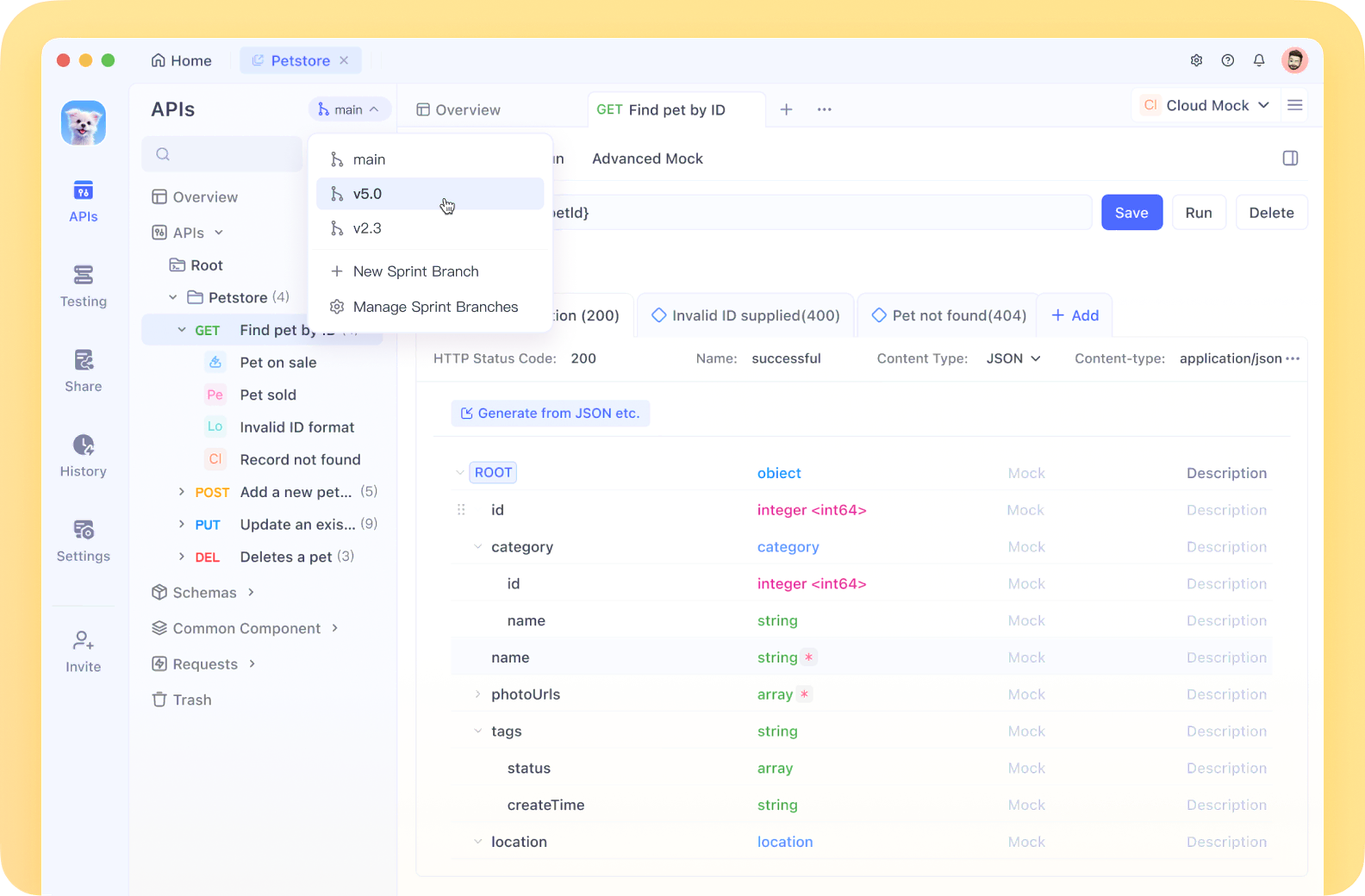
What is Gemini 2.5 Flash with Cursor & Cline?
Gemini 2.5 Flash is Google’s latest AI model, launched in 2025, optimized for speed and efficiency in coding, text generation, and reasoning tasks. Cursor is an AI-powered code editor built on VS Code, with a chat interface and Composer for seamless code creation. Cline is a VS Code extension that acts as an autonomous coding agent, editing files and executing tasks. Together, they let Gemini 2.5 Flash power your coding, from generating functions to fixing bugs. Since both tools directly support Gemini 2.5 Flash, setup is a breeze. Let’s get it running and code a factorial function!

Setting Up Your Environment: The Basics
Before we unleash Gemini 2.5 Flash in Cursor and Cline, let’s get your system ready. This is super beginner-friendly, with each step explained so you’re never lost.
Check Prerequisites
Make sure you have these tools installed:
- Python: Version 3.10 or higher. Run
python --versionin your terminal. If it’s missing or outdated, download from python.org. Python is essential for Cline and our test scripts. - VS Code: Required for Cline. Check with
code --versionor install from code.visualstudio.com. - Node.js: Needed for Cursor’s dependencies. Verify with
node --versionor get it from nodejs.org. - Hardware: A 4+ core CPU, 16GB+ RAM, and 10GB+ free storage to handle AI processing smoothly.
Missing anything? Install it now to avoid bumps down the road.
Install Cursor: If you’re using Cursor, download it from cursor.com for macOS, Windows, or Linux. Install and launch it—it’s a VS Code-inspired editor with AI magic built in.
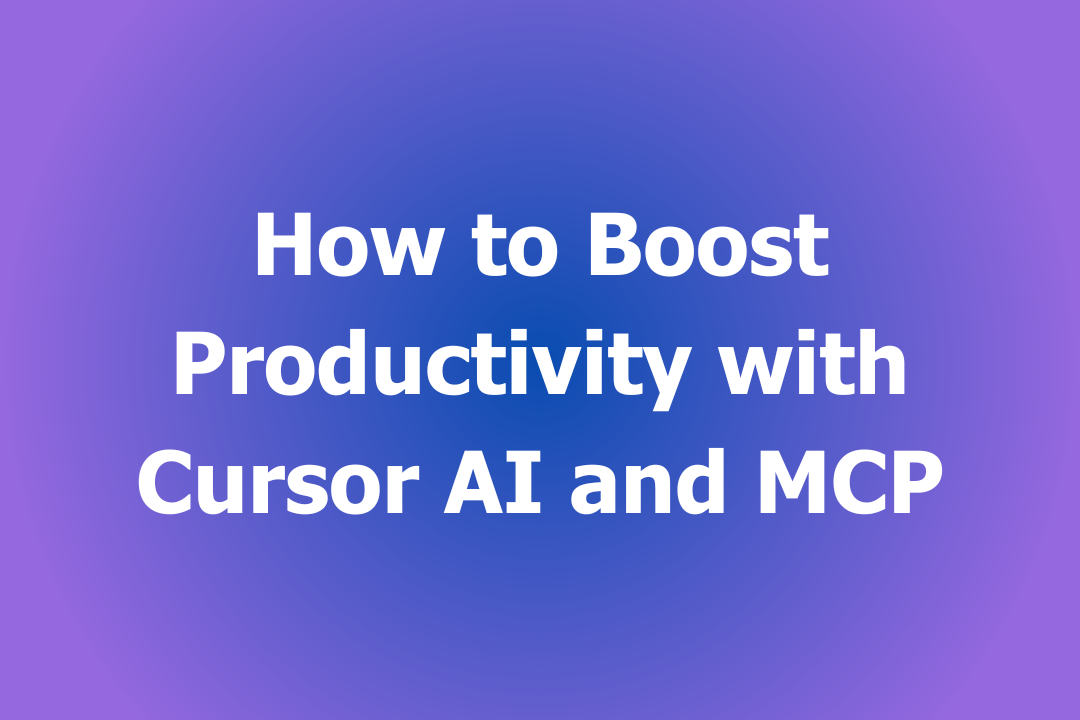
Create a Project Folder
Let’s keep things organized:
mkdir gemini-coding
cd gemini-coding
This folder will house your Gemini 2.5 Flash projects, and cd sets you up for action.
Set Up a Virtual Environment
To keep Cline’s dependencies tidy, create a Python virtual environment:
python -m venv venv
Activate it:
- Mac/Linux:
source venv/bin/activate - Windows:
venv\Scripts\activate
The (venv) prompt in your terminal means you’re in a clean Python environment, preventing conflicts with other projects.
Open in Cursor or VS Code
Launch your editor:
code . # For VS Code
Or open Cursor manually. This preps your workspace for coding with Gemini 2.5 Flash.
Installing Cline and Dependencies
Let’s get Cline set up in VS Code to work with Gemini 2.5 Flash, along with any dependencies needed for our test.
Install Cline Extension: In VS Code:
- Open the Extensions view (
Ctrl+Shift+XorCmd+Shift+Xon Mac). - Search for “Cline” and click Install. This adds Cline’s autonomous coding features, letting it edit files and respond to prompts.
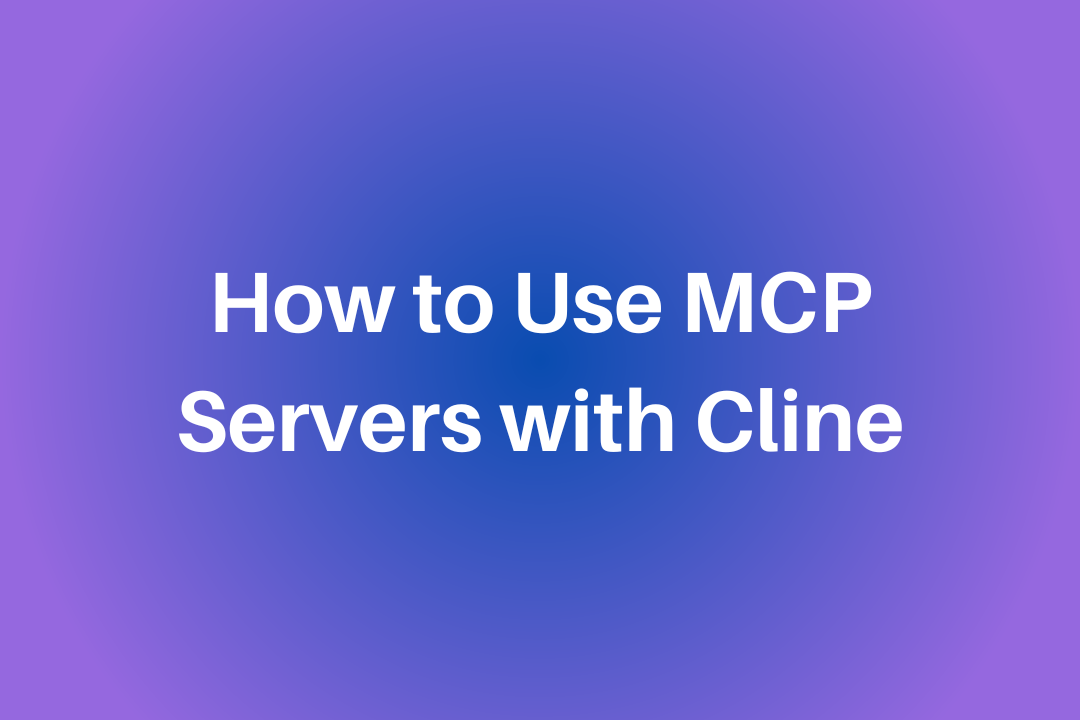
Install Python Dependencies: While our test doesn’t need extra packages, let’s install a basic dependency for future Gemini 2.5 Flash projects:
pip install requests
The requests library is handy for API-based tasks, though our factorial example won’t use it. This ensures your environment is ready for more complex coding later.
Verify VS Code Setup: Check that Cline appears in the VS Code sidebar (a chat-like icon). If it’s missing, restart VS Code and confirm the extension is enabled in the Extensions view.
Configuring Gemini 2.5 Flash with Cursor & Cline
Great news—both Cursor and Cline directly support Gemini 2.5 Flash, so we just need a Google API key and a few clicks to set it up. Let’s configure both tools to unleash Gemini 2.5 Flash's coding powers.
Get a Google API Key
To use Gemini 2.5 Flash, you’ll need an API key from Google:
- Visit ai.google.dev and sign up or log in.
- Navigate to the API section (usually under your account or “API & Services”).
- Create a new project if prompted, then enable the Gemini API.
- Click “Create API Key” and select Gemini 2.5 Flash (or the Gemini family if specific models aren’t listed). If you don’t see Gemini 2.5 Flash, ensure your account has access (you may need to request it, as it’s new in 2025).
- Copy the key and store it securely (e.g., in a password manager). This key authenticates your Gemini 2.5 Flash requests, so keep it private.
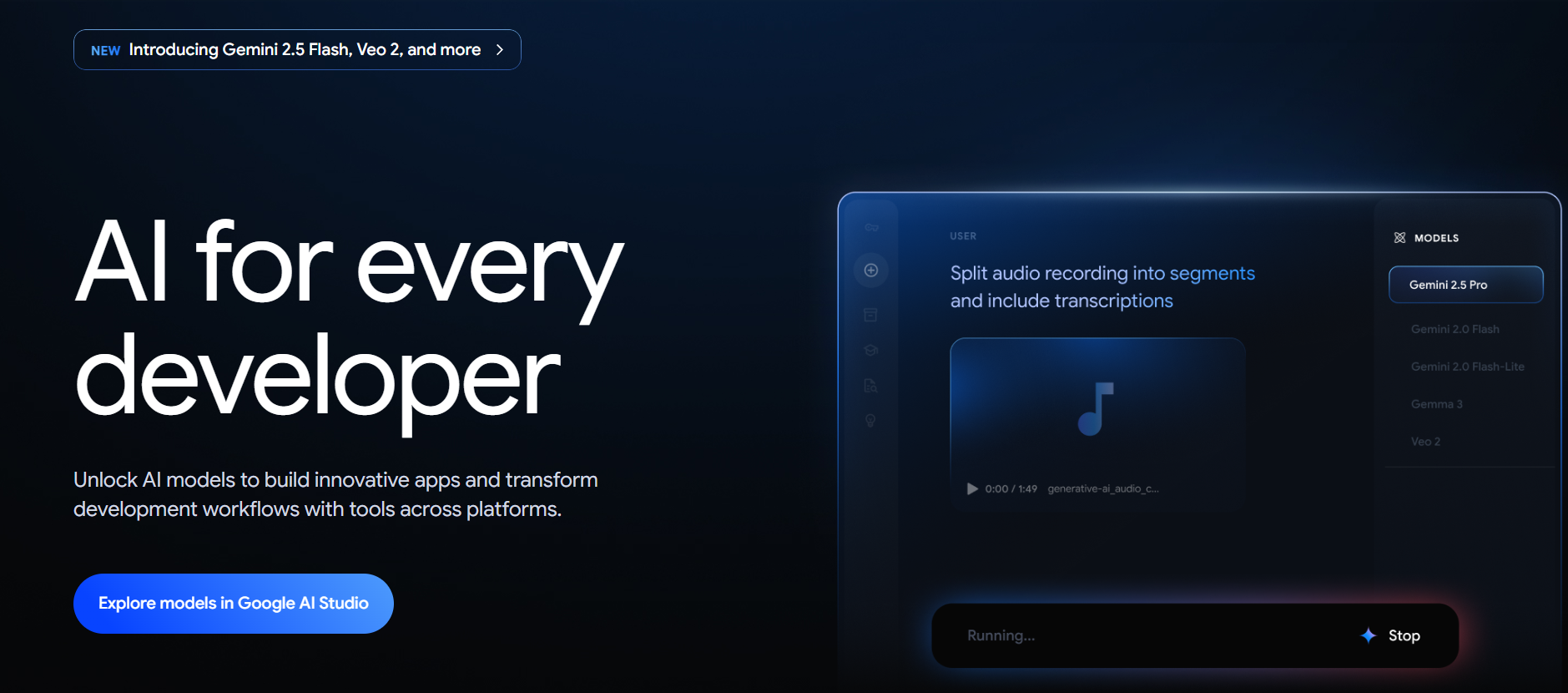
Configure Cursor with Gemini 2.5 Flash:
- Open Cursor and head to Settings (
Ctrl+,orCmd+,on Mac). - Find the “Models” section, which lists available AI models.
- Select
Gemini 2.5Flash from the dropdown. Since Cursor supports Gemini 2.5 Flash directly, it should be available if your app is updated (check for updates in Cursor’s menu if not). - In the “API Keys” section, paste your Google API key from step 1.
- Save the settings. To test, open the Composer panel (
Ctrl+IorCmd+I) and type “Hello”—Gemini 2.5 Flash should reply. This seamless integration makes Cursor a fantastic platform for Gemini 2.5 Flash coding.
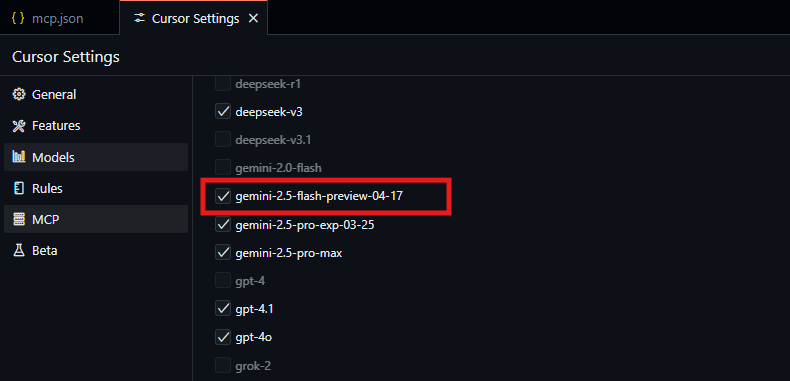
Configure Cline with Gemini 2.5 Flash:
- In VS Code, open Cline’s sidebar (the chat-like icon).
- Click the options button (gear or three dots) and select “Configure API Provider.”
- Choose “Google Gemini” from the provider list.
- Paste your Google API key and select
Gemini 2.5Flash from the Model dropdown. If it’s not listed, ensure your VS Code and Cline are updated, or contact Google support for API access. - Test by typing “Hello” in Cline’s chat window—it should respond via Gemini 2.5 Flash. This direct setup lets Cline tap into Gemini 2.5 Flash coding smarts effortlessly.
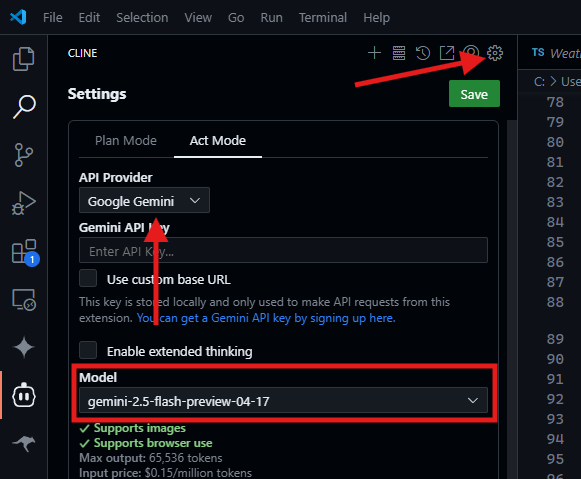
Understand Gemini 2.5 Flash Pricing
Using Gemini 2.5 Flash involves costs, so let’s break it down based on Google’s pricing:
Free Tier Perks: Good news—Gemini 2.5 Flash offers a free tier! Input and output tokens are free of charge, making it perfect for testing. You also get grounding with Google Search for free, up to 500 requests per day (RPD). This means you can experiment with prompts in Cursor and Cline without spending a dime, as long as you stay within these limits.
Paid Tier Costs: If you go beyond the free tier, here’s what you’ll pay per 1M tokens (in USD):
- Input Price: $0.15 per 1M tokens for text, image, and video inputs. Audio inputs are pricier at $1.00 per 1M tokens. A typical coding prompt in Cursor or Cline (e.g., “Write a Python function”) might use ~500 input tokens, costing just $0.000075 ($0.15/1M * 500)—basically a fraction of a cent!
- Output Price: Non-thinking responses (quick answers) cost $0.60 per 1M tokens, while thinking responses (deeper reasoning, like for complex coding tasks) are $3.50 per 1M tokens. For a prompt generating ~200 output tokens with non-thinking, that’s $0.00012 ($0.60/1M * 200). If it’s a thinking response, it’s $0.0007 ($3.50/1M * 200).
- Grounding with Google Search (Paid): Beyond the free 500 RPD, grounding costs $35 per 1,000 requests. For example, 1,500 RPD (after the free 500) would cost $35.
To save costs, use concise prompts and check your Google Cloud dashboard for usage. If you’re on a tight budget, stick to simple tasks to stay within free credits.
Set Environment Variables (Optional)
For scripts or to avoid hardcoding API keys, add your Google API key to your shell profile (e.g., ~/.zshrc on Mac/Linux):
export GOOGLE_API_KEY="your-google-api-key"
Reload with source ~/.zshrc. This keeps your key secure and ready for future Gemini 2.5 Flash projects.
Testing Gemini 2.5 Flash in Cursor & Cline
Let’s test Gemini 2.5 Flash in Cursor and Cline with a simple task: “Write a Python function to calculate the factorial of a number.” This keeps things easy, showcasing Gemini 2.5 Flash's coding skills without complex steps.
Test in Cursor:
- Open Cursor and confirm Gemini 2.5 Flash is selected in Settings > Models.
- Create a new file or open the Composer panel (
Ctrl+IorCmd+I). - Type: “Write a Python function to calculate the factorial of a number.”
- Gemini 2.5 Flash will generate something like:
def factorial(n):
if n < 0:
raise ValueError("Factorial is not defined for negative numbers")
if n == 0 or n == 1:
return 1
return n * factorial(n - 1)
- Add a test line to check it:
print(factorial(5)) # Outputs: 120
- Run the code in Cursor by clicking the “Run” button or pressing
Ctrl+Enter. I got120(5! = 5 * 4 * 3 * 2 * 1)—perfect! If it doesn’t work, check your API key in Cursor’s settings or ensure you’re online. This direct integration makes Gemini 2.5 Flash a joy to use in Cursor.
Test in Cline:
- In VS Code, open Cline’s sidebar and verify Gemini 2.5 Flash is set as the model (Google Gemini provider).
- Type the same prompt: “Write a Python function to calculate the factorial of a number.”
- Cline will generate a similar function, offering to save it as
factorial.py. Approve the file creation if prompted. - The code will match the one above. Add a test line:
print(factorial(5)) # Outputs: 120
- Run by right-clicking the file in VS Code and selecting “Run Python File in Terminal” or using:
python factorial.py
- My test output
120, and Cline saved the file neatly. If Cline doesn’t respond, check your Google API key and model selection in Cline’s settings. This shows Gemini 2.5 Flash's coding prowess through Cline’s automation.
Understand the Test Results: The factorial function is a perfect test—it’s simple but demonstrates Gemini 2.5 Flash's ability to produce correct, recursive code. The output 120 confirms the model understood the task. If you see errors, ensure Cursor or Cline is using Gemini 2.5 Flash and your API key has credits.
Tips for Using Gemini 2.5 Flash Effectively
To get the most out of Gemini 2.5 Flash in Cursor and Cline:
- Be Specific with Prompts: “Write a Python function to calculate the factorial of a number” is clearer than “Do math.” Clear prompts help Gemini 2.5 Flash deliver spot-on code.
- Use Cursor’s Composer: For complex tasks, use Composer (
Ctrl+I) to iterate on code, as it’s great for refining Gemini 2.5 Flash output. - Leverage Cline’s Automation: Let Cline save files and run commands for repetitive tasks, saving you clicks.
- Monitor API Usage: Track your Google Cloud usage to stay within free credits, especially for frequent prompts.
My Takes on Gemini 2.5 Flash with Cursor & Cline
After playing with Gemini 2.5 Flash, here’s my vibe:
- Lightning Fast: Gemini 2.5 Flash cranked out the factorial function in seconds, with clean, correct code.
- Cursor’s Simplicity: The direct model selection and Composer make coding feel effortless.
- Cline’s Power: Auto-saving files and executing tasks is a game-changer for productivity.
- Smooth Setup: Direct support in both tools means no fiddly workarounds—just plug in your API key and go.
If you hit issues, double-check your API key and model selection in Cursor or Cline.

Wrapping Up: Your Gemini 2.5 Flash Coding Adventure
Congrats—you’ve unlocked Gemini 2.5 Flash in Cursor and Cline, making your coding sessions pure magic! From whipping up a factorial function to tackling bigger projects, you’re set to shine. Try generating a web scraper or debugging code next. And for more, check Google’s Gemini API docs, and keep rocking with Gemini 2.5 Flash, Cursor, and Cline!



